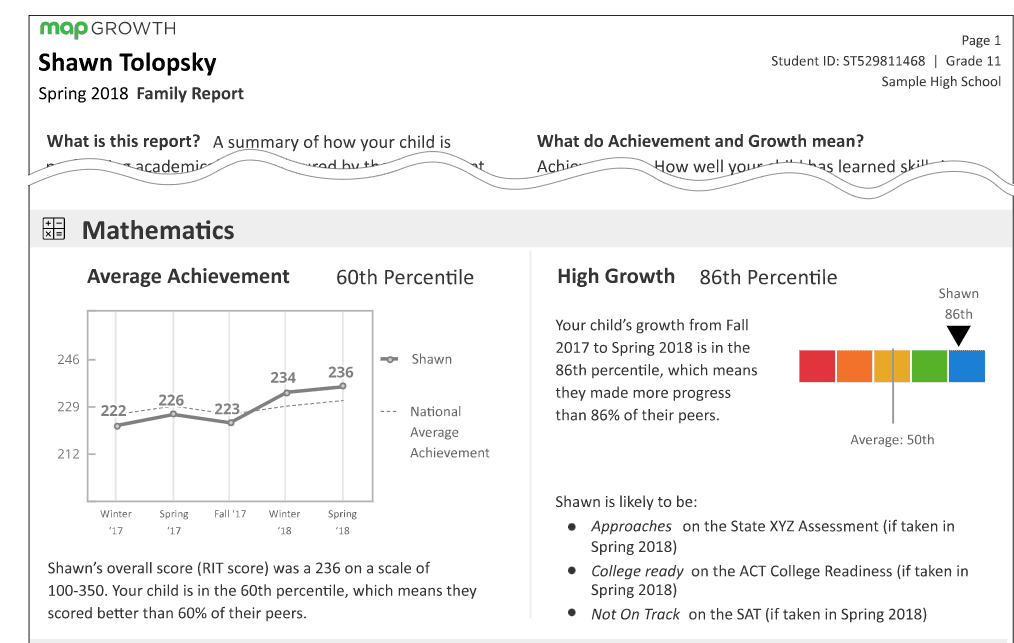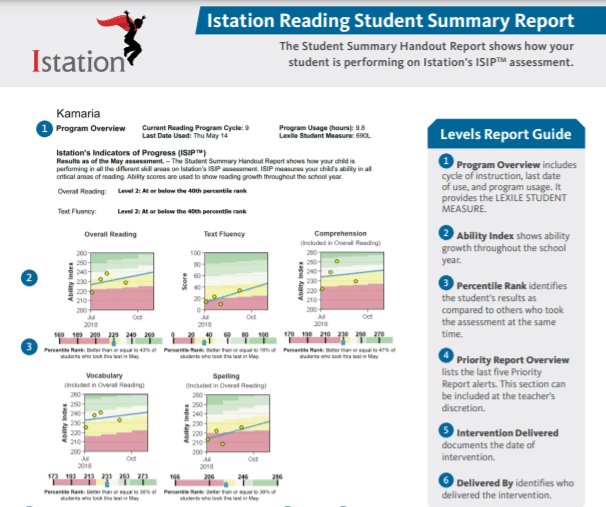In Leander ISD, we use a universal screener, such as MAP Growth and Istation’s Indicators of Progress (ISIP), to determine what the student knows and is ready to learn next. The assessment information will support teachers in knowing the instructional areas in which students have grown and are ready to learn.
NWEA MAP Growth Testing Information
For an overview, please watch this What is MAP Growth video. The “A Family Guide to Map Growth” handout contains basic information about Northwest Evaluation Association (NWEA) and MAP Growth as a screening tool.
MAP Growth Frequently Asked Questions
Who will take the MAP Growth screener?
All students in grade K–8 will take this assessment in Mathematics. For high school, students will take MAP Growth Reading, Mathematics, and Science in grades 9-11.
When will my child take the Math MAP Growth screener?
Students will take the assessment three times a year; Fall, Winter and Spring during a district determined window. Students will take the screener during class.
What is a RIT Score?
A RIT score is an estimation of a student’s instructional level and also measures student growth or progress. You may have a chart in your home on which you mark your child’s height at certain times, such as on their birthday. This is a growth chart to show how much they have grown from one year to the next. MAP assessments do the same sort of thing, except they measure your student’s growth.
The RIT scale ranges from 100–350. RIT scores make it possible to follow a student’s educational growth from year to year. As an example of how math RIT scores change as students move from grade to grade, a student may score in the 170s in third grade and advance to the 220s by high school.
What is a passing RIT score on the MAP Growth screener?
The MAP Growth assessment is not a test for mastery. It is designed to inform the instructional areas in which students are ready to learn. There is not a passing score as it is an assessment FOR learning rather than OF learning. The RIT score is based upon data from students nationwide and is used as a scale to compare scores to normed scores across the country.
What is a percentile rank?
A percentile rank indicates how well a student performed in comparison to the students in the specific norm group; for example, in the same grade and subject. A student’s percentile rank indicates that the student scored as well as, or better than, the percent of students in the norm group. For example, a student scoring at the 35th percentile scored as well as, or better than, 35 percent of students in the norm group. It also means that 65 percent of the students in the norm group exceeded this score.
The percentile rank is not a percentage of items the student answered correctly.
How is the MAP Growth screener different from the STAAR test?
Unlike standardized tests, MAP Growth is administered three times during the school year, and it adjusts to each student’s performance, rather than asking all students the same questions. When we talk about high-stakes tests, we are usually talking about a test designed to measure what students already know, based on what is expected at their grade level. High stakes tests are also often used as a way to measure grade-level proficiency. MAP Growth is designed to measure student achievement in the moment and growth over time, regardless of grade level, so it is quite different.
When will I receive a score report for my child?
Since the MAP Growth screener is designed to measure growth over time, family reports will be shared after our second testing session in the spring semester. Below is a sample report showing the way data will be represented on the report. Each year, this data will follow the student with cumulative data as you can see in the example below:

MAP Growth Report Sample – Spanish
How will my child’s teacher use his/her RIT Score?
Teachers can use the score to inform instruction, personalize learning, and monitor the growth of individual students. Principals and administrators can use the scores to see the performance and progress of a grade level, a school, or the entire district. Remember, your child’s MAP Growth RIT score is not a grade. Instead, it is a single data point that helps their teacher know what they are ready to learn next. It is there to help inform the teacher’s instructional decisions.
Istation’s Indicators of Progress (ISIP) Reading Testing Information
Nationally normed Istation’s Indicators of Progress (ISIP) measure student growth with engaging, computer-adaptive diagnostic and screening programs. Readers are assessed in approximately 30 minutes with a computer-adaptive assessment in the following categories: vocabulary, word analysis, reading comprehension, and text fluency. Based on the ISIP results, learners are placed in interactive online instruction.
The purpose of ISIP is to measure readiness for grade level instruction, screen to identify students who are at-risk for struggling with core instruction, determine if and degree of intensity of interventions needed, and progress monitor and track growth.
ISIP Frequently Asked Questions
Who takes the ISIP Reading?
All students in grade K–8 take this assessment.
When will my child take the ISIP?
- The monthly assessments are given the first time a student logs on during a calendar month. For example, if a student logs in on Sept. 1, an ISIP Assessment will be given. If the student doesn’t log in until Sept. 15, an ISIP Assessment will still be given when the student logs in.
- Additional On-Demand Assessments can be given at any time during the school year.
- ISIP Assessments can be used as benchmarks and as continuous progress monitoring tools. In Leander ISD, students will take the assessment a minimum of three times a year: Fall, Winter, and Spring, during district-determined windows. Students will take the screener during their English Language Arts class during the school day.
What is Computerized Adaptive Testing (CAT)?
ISIP integrates computerized adaptive testing that accurately reflects the reading ability level of each student and measures growth over time.
Adaptive assessments use interactive content to measure a student’s reading ability and skill development. Test questions range from easy to hard for each reading domain for PreK through 12th-grade students. To identify the student’s overall reading ability and individual skill ability, the difficulty of the test questions presented changes with every response. If a student answers questions correctly, ISIP presents more challenging questions until the student shows mastery or responds with an incorrect answer. When a student answers a question incorrectly, ISIP will present less difficult questions until the student begins answering correctly again. The ability score shows how a student is doing compared to their previous performance and to other students at the same grade level.
What is a percentile rank?
National norms for ISIP Reading are provided for students in Prekindergarten through Grade 8. These norms enable teachers, parents, and students to know how their students’ scores compare with a nationally representative sample of children in their particular grade.
A percentile rank indicates how well a student performed in comparison to the students in the specific norm group, for example, in the same grade and subject. A student’s percentile rank indicates that the student scored as well as, or better than, the percent of students in the norm group. For example, a student scoring at the 35th percentile scored as well as, or better than, 35 percent of students in the norm group. It also means that 65 percent of the students in the norm group exceeded this score.
The percentile rank is not a percentage of items the student answered correctly.
What is an Ability Index?
ISIP assessments use a measurement scale that aligns student performance levels with test question difficulties on the same scale. The scale used is divided into equal parts. These parts are called ability indices. All test questions are placed on the ability index scale according to their difficulty. Each increasing ability index is assigned a numeric value that indicates a higher level of difficulty. As a student takes an ISIP assessment, he or she is presented with test questions of varying ability indices or levels of difficulty. Once ISIP determines the difficulty level at which the student is able to perform, the test ends and the student is assigned an overall reading ability index, as well as ability indices for individual subtests.
Since ISIP is adaptive and the test questions are displayed based on student performance, not age or grade, identical ability indices across grades mean the same thing. For example, a first-grader who received a score of 215 and a third-grader who received a score of 215 are performing at the same level.
This ability index can be used by teachers to inform instruction around their students’ strengths and weaknesses. Targeted instruction leads to better performance and maximum growth.
When will I receive a score report for my child?
Student Summary Reports will be shared after the middle-of-year administration. The report shows data points this year. Below is a sample report showing the way data will be represented on the report.

iStation Sample – Spanish
How can parents access additional information and resources?
Istation provides a parent portal. For more information to gain access to the parent portal and parent log-in credentials, please reach out to your child’s English Language Arts teacher.
How will my child’s teacher use his/her ISIP Scores?
Teachers can use the score to inform instruction, personalize learning, and monitor the growth of individual students. Principals and administrators can use the scores to see the performance and progress of a grade level, a school, or the entire district. Remember, your child’s ISIP Overall score is not a grade. Instead, it is a single data point that helps their teacher know what they are ready to learn next. It is there to help inform the teacher’s instructional decisions.
